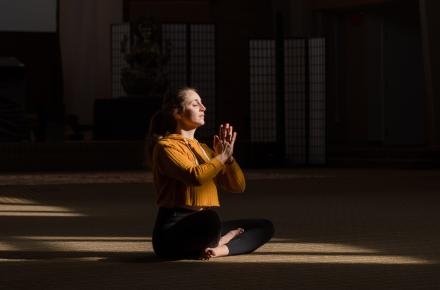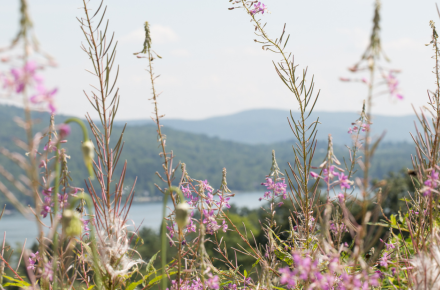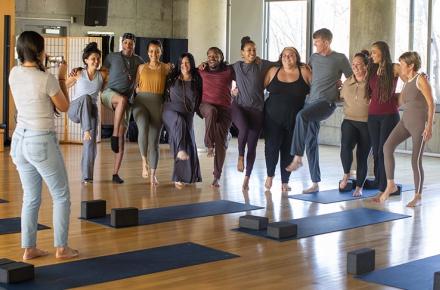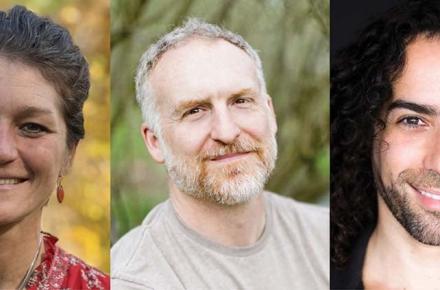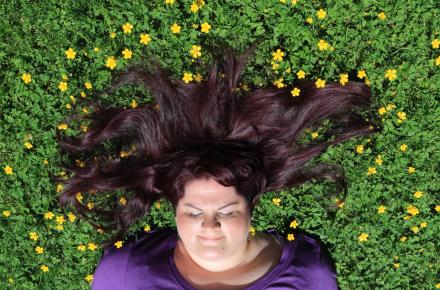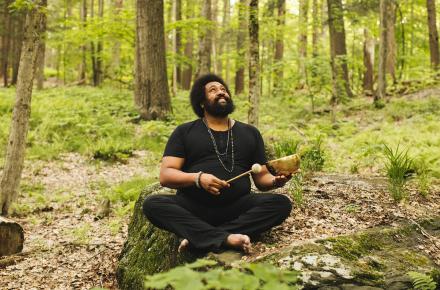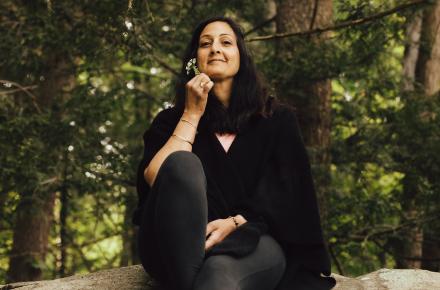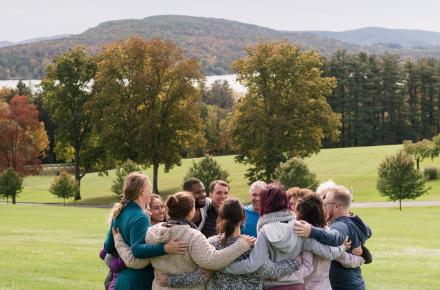The Masks of the Goddess
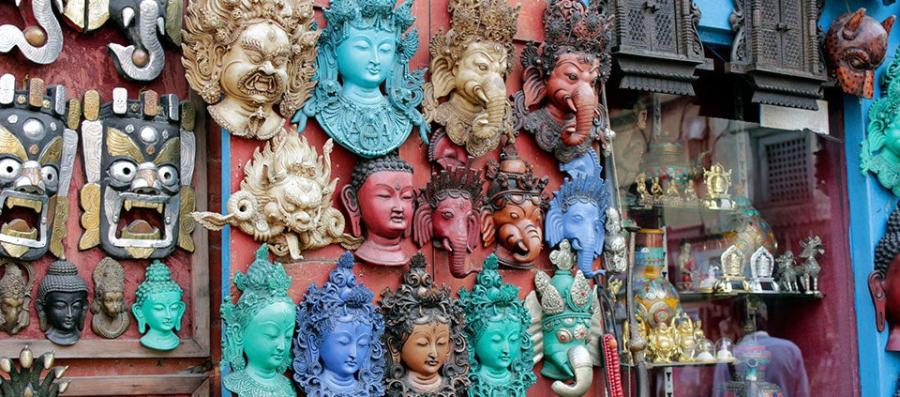
by Lauren Raine, MFA
Myth comes alive as it enters the cauldron of evolution, itself drawing energy from the storytellers who shape it.
—Elizabeth Fuller, actress
In 2002 I had a conversation with Dorit Bat Shalom, a wonderful Israeli artist who creates international "Peace Tents", places for both Israeli and Palestine women to come together in order to celebrate their stories, their art, and their differences. As we spoke about the war, she asked, "How can there be lasting peace without the Shekinah? The Shekinah has been driven away from the holy lands, and we cannot really heal without Her."
The Shekinah is the Female aspect of God in Judaism, in early Christianity, the Divine Feminine called Sophia, a Greek word that also meant "wisdom". How indeed can there be lasting peace, as Dorit said, without the Goddess? When we are a humanity divided against itself? Myths are the templates of art and religion, the templates upon which both civilizations and individuals name what is sacred and what is profane.
"The mythologies of our present culture are heading us to destruction," art critic Suzi Gablik wrote in The Reenchantment of Art (1989). "We are being called upon to participate in revising the mythic assumptions we follow." As artists and cocreators, we are always engaged in re-mything our cultural assumptions—dreaming the future into existence. The return of the Great Mother is accomplished as women and men rediscover and invent Her symbols and stories, restoring them to the contemporary imagination.
We are the great work of art in progress.
We, ourselves.
—Rafael Montanez Ortiz, performance artist
When I studied mask art in Bali, I realized that the Balinese had no understanding of our western discourse on the meaning of art; art, to them, is a way to commune with the deities and spirits of their Hindu religion. Temple masks are not "art objects"—they are vessels for their stories; they "belong to the Gods."
In traditional cultures, drama and dance are about worship. Masks are never made lightly. Animated by the body, masks are threshold tools that mediate between this world and the realms of spirit. There are many procedures to be followed, including choosing the right materials from the right place, asking ancestral spirits what kind of mask is required for specific ceremonies, and consecrating the finished work. A great deal of preparation was necessary, and masks were activated and de-activated with great respect. To wear a ceremonial mask without preparation was to invite the deity of the mask to "possess" the wearer, entering into an embodied state.
As psychologist Stephen Larsen commented in The Mythic Imagination: "The primary function of the mask is to unite the indwelling wearer (and the observer) with a mythic being, or as Jung would say, ’an archetypal power’. The mask, as we have found in our own work, becomes a transformer of energy, a medium of exchange between ego and archetype. Thus in traditional societies one finds taboos surrounding the mask, its recognition as a power object."
Among natives of central Mexico, masks used for corn and rain dances were destroyed after a number of years, because they believed they accrued too much power over time, and could become dangerous as the spirit of the deity increasingly inhabited the mask. This sensibility is also found in Japanese Noh Theatre. Noh masks are created according to traditions that go back many generations to represent personae that have firmly become animated by the mask. Actors will often sit for days with a mask, creating fusion with the character.
An artist I know once told me of an African mask at the Museum of Art in Milwaukee that, legend had it, sweated. She said she went to view it over a number of days, and sure enough, there it was, if carefully observed, sweating away. How is it possible that something like that can occur in a glass case before hundreds of people unnoticed? Magic is literally on display.
Sacred Theatre, to me, is about giving play and voice to our multi-dimensional being. We dance and are danced, and find ourselves engaged in a great mysterious conversation. "We’re really praying," Drissana Devananda, a tantric dancer, said about dancing Kali. "It’s a devotional practice. We’re not bodies seeking the spirit, but spirits seeking bodily experiences. Dance is about remembering to function from our whole bodies, the ’bodymind.’ That is the place we remember the Goddess."
What happens when we invite the archetypal powers, the Goddesses and Gods, into our circle? The answer is: "If you build it, they will come." There is a magnetic field the dance engages, a field of relatedness we seem to step into. "When you create within a sacred paradigm," playwright Elizabeth Fuller said, "you find a strange thing. You are communicating with, and being fed by, sources you know are within you, but have a much greater reflection somewhere else. You are in touch with something timeless."
Circle Art
A "theatre of the Goddess" is about circle work. As the group becomes a strong container, it generates energy that flows to the audience and beyond, an expanding circle with no end. "Circularity," like nature, is its essence. The wheel of the elements, of the year, circulate. Water and wind move across the landscape like a sinuous snake. All things circle and wind and spiral. So does our creativity.
Masks are also about circles. To me, masks are an impeccable metaphor for the personae that encircle our souls. Who are we, really? Better minds than mine have argued the question, but I do know that in the course of our lives we inhabit a noisy council of selves. The living metaphor of the mask leads perfectly into that essential inquiry. Is this me? Or this? Can I wear this mask, become it for a while, express its unique qualities, feel it in my body, find its words?
I believe we are transformed into more compassionate beings when we can witness, embrace, and truly celebrate the "circle of self," from dark to light, mundane to divine, as the whole being each of us really is. Not as an abstract concept, but as an authentic experience to be had within our spontaneous, creative imaginations, and in the sensory, visionary immediacy of our bodies. How can we dance more lightly with the mask that is ever-changing? One way is to consciously put on, and take off, our "faces," becoming more self-aware shape shifters.
Each mask has its reserve of energy, its story. Women (and men) exploring archetypes of the Goddess may chose to work with an archetype for specific reasons, sometimes to call back something they feel has been lost. A woman named Turquoise discovered a joyful opportunity to reconnect with "the wild woman" when she decided to dance Artemis. "I found," she wrote, "renewed love for the animals, the trees, for all living things. I saw my surroundings illuminated with light, the light of nature."
Some may find themselves drawn to a figure they do not think they know. Sometimes an archetype draws them because there is something yet unseen, or perhaps, unhealed. Enacting the myth of Inanna’s descent to her dark twin Ereshkigal has been powerful visioning for many women into the underground of their own psyches. Dwelling in grief and solitude in the underworld, Ereshkigal may be understood as the "shadow self". And the suffering and cruelty of Ereshkigal is a difficult mask to meet. Yet the descent and rebirth of Inanna is among the most powerful universal myths of death, fragmentation, and psychic integration ever told: the "journey of the wounded healer."
The Goddess within can also manifest in many intimate, contemporary ways. She is a living presence expressed in the here and now of our lives. Three young women danced Lilith as three aspects: dark-winged Lilith, Lilith cast out of Eden, and finally, Lilith as she appears today—a vamp. One of the best invocations of Aphrodite was done to jazzy, "strip tease" music.
"Mystery" derives from a Greek word, myein, which means "to keep silent". There are Gnostic experiences that cannot be spoken because they are, simply, larger than any word can express. Their expression belongs to dreams, art, and myth. That was surely why the Elusinian rites of Greece and Rome, which endured for 2,000 years, were called "Mysteries." One of the most eloquent conversations I have been privileged to share was with a priestess and activist, Ann Weller, who took on the difficult task of invoking the Dark Goddess for a community ritual in 2000. Its purpose was to symbolically enact, witness, and transform through their ceremony the violence of the past century.
As Ann described her experience: "The Dark Goddess is found in many cultures by many names, and is not aspected lightly. Working with Her calls forth an internal capacity for psychic empowerment, an energy not easy for our limited ego selves to encompass. Because the work is, I believe, ultimately, impersonal. I was a brief vessel for an immense intelligence manifesting within the drama we created. And yet, the experience did bring personal change. You can’t work with sacred theatre and not be changed in some way. I was being re-constructed, whether I was aware of it or not, to better serve Her. I found myself confronting aspects of myself that were just not useful anymore. Which meant better serving myself. That’s how I look at it. The little overlay of how I imagined myself, which had never been very effective, was now utterly obvious to me. My authentic power began to manifest."
When we reclaim the Goddess, Her ancient myths and contemporary meaning, we are restoring the balance. We’re planting seeds of hope that will bloom in their own unique ways as we struggle to become whole—in our lives and in the lives of those we share our journeys with.
There is a way of knowing that we are the artists of our lives, a way of seeing our creativity as a conversation we are having with an infinitely creative, conversant world. We’re dancing the future into the world by the stories we tell: may we dance empathy instead of despair, may we tell the stories and reclaim the myths that make life sacred and loving, profound and reverent, for today and for the future.














